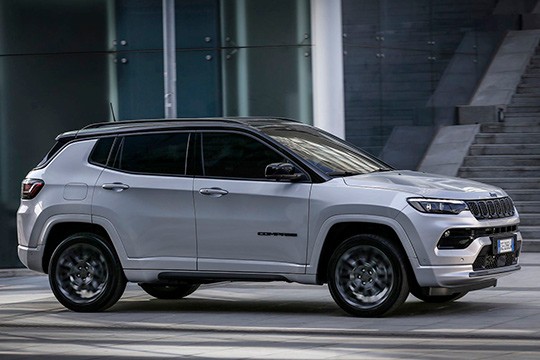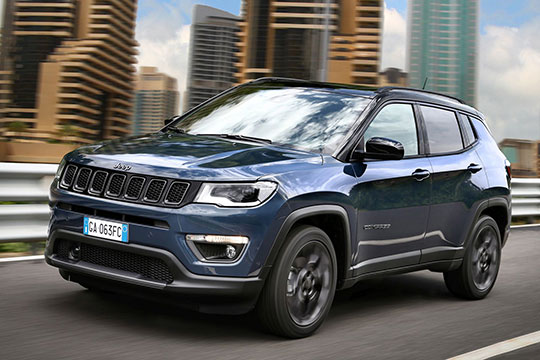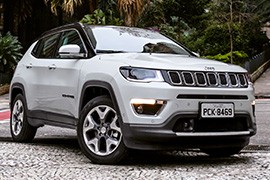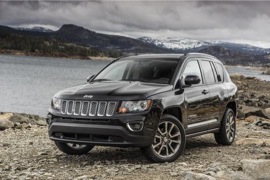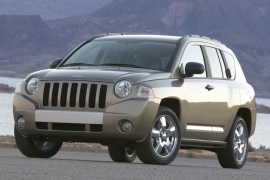JEEP Compass Models/Series Timeline, Specifications & Photos
First production year: 2006
Engines: Gasoline, Hybrid gasoline, Diesel
Body style: SUV (Sports Utility Vehicle)
Jeep launched the refreshed version of the second generation of the Compass in July 2021 at the Chicago Auto Show as a 2022 model year, and the changes were massive.
2021 was a significant year for the Stellantis Group, which was formed in January of the same year. It was rebranded after FCA (Fiat Chrysler Automotive) and PSA (Peugeot, Citroen, and Opel) combined their efforts to create a sustainable company. One of the most significant models in the automaker’s lineup was the second generation of the Compass, which was already five years old. The new model came with essential updates on the exterior, a completely redesigned cabin, and new or improved engines, depending on the market. The Compass had a tough time fighting on both sides of the Atlantic other brands, and the refreshed version hoped to overcome its direct competitors in the compact crossover segment with some Jeep-specific attributes, especially with its off-road performance.
At the front, the 2022 Jeep Compass boasted a new grille that featured piano-black accents around the seven-slat grille, specific for the brand. In addition, the automaker created new headlights featuring LED daytime running lights integrated into their upper side, making the car look meaner. On the lower side of the bumper, the automaker offered LED fog lamps to accompany the broad air intake placed in the middle. Jeep also added a skid plate for the Trailhawk grade of the Compass.
From its profile, the automaker added body-colored cladding around the wheel arches, while its predecessor was available exclusively with matte-black ones. Starting with this model year, the trim levels of the Compass differed even more. There was a new choice of alloy 19-inch alloy wheels with a black or silver finish for the higher grades. On the Trailhawk trim level, the automaker installed a matte black grille and a specific red and black decal on the hood. It also sported red tow hooks on the lower side of the bumper, above the skid plates. Unlike the Longitude and the Limited, this rugged version rode on 17-inch wheels wrapped in beefier all-terrain tires.
However, the most significant change was inside the vehicle. The dashboard was entirely new, and Jeep placed a 10.25-inch digital instrument panel fronting the driver. It provided 24 customizable content screens. Atop the center stack, in a free-floating position, the Compass was available with a standard 8.4-inch touchscreen for base versions, while the upper grades had received a 10.1-inch one. All versions featured wireless Apple CarPlay and Android Auto. The automaker understood the needs of its customers and placed more USB ports for the front and rear passengers. In addition, the Compass had an induction charger for mobile phones. In the back, the bench seat was redesigned, providing more comfort for its occupants, and for the first time in the model’s history, it featured heating.
Under the hood, the engine lineup differed depending on the market and had something for every taste. Besides the 2.4-liter gasoline powerplant (later replaced by a two-liter turbocharged unit), it was also available with turbodiesel and plug-in hybrid versions. The Trailhawk boasted a higher ground clearance than the rest of the range and a two-speed transfer box.
Jeep had to prepare the second generation of the Compass for the European market and adapt it to the customers' needs, and that took almost three years from the moment it launched the model to the first deliveries.
While the first generation of this nameplate was developed during the DaimlerChrysler era, the 2018 model was made in cooperation with Fiat on a platform named FCA Small Wide LWB 4x4, shared with the Fiat 500 X, which had been on the market since 2014. The new model came with significant improvements over its predecessor. It still featured similar off-road abilities typical for a Jeep but added more comfort and street-oriented values to make it attractive to European customers.
With a front fascia that resembled the Grand Cherokee, the second generation of the Compass featured horizontal headlights with clear lenses that flanked the classic seven-slat Jeep grille, available with chromed inserts. The hood featured a center bulge and a double break line. At the same time, Jeep also installed a lower bumper fitted with a mid-section that sported an air intake neatly integrated into a matte-black element, which mimicked a skid plate. On the sides, a pair of fog lamps surrounded by chromed decorations were also available.
From its profile, the car revealed its crossover stance but with an off-road appeal emphasized by the black trims applied on the squarish-looking wheel arches and matching color side sills. Jeep sold the Compass in Europe in four grades: Sport, Longitude, Limited, and Trailhawk. In addition, a Night Eagle package was available for the second grade, creating a meaner look for the compact SUV. Thanks to its short overhangs, the Compass boasted 16.8 and 31.7 approach and departure angles, respectively, while the Trailhawk had those values increased to 30 and 33.8, respectively. Those values were far above any of its direct competitors from the European market. Finally, at the back, the Compass had a slightly tilted forward tailgate adorned by a roof spoiler and flanked by LED taillights.
Inside, the automaker tried to impress European customers with modern features, which were either standard or available depending on the grade. Up front, Jeep installed a pair of bolstered bucket seats with cloth or leather upholstery, separated by a center console that housed the gear stick (or the gear selector for the automatic transmission), the drive mode knob, and a pair of cup holders. In addition, a raised center armrest with a storage compartment underneath ensured the driver's and their side passenger comfort. Atop the center stack, the automaker installed a 5-inch touchscreen for the Uconnect infotainment system as standard on the Sport grade, while all the others boasted an 8.4-inch unit with integrated Android Auto and Apple CarPlay. At the back, the split-folding bench seat could expand the 438-liter (15.5 cu-ft) trunk.
Under the hood, the 2019 Jeep Compass was fitted with a choice of turbocharged gasoline and diesel engines, ranging between 120 PS (118 hp) and 170 PS (168 hp). Depending on the grade and traction system, the automaker paired them with a five-speed manual, a six-speed automatic (dual-clutch), or a nine-speed automatic transmission. In addition, the Trailhawk featured a two-speed transfer box with low range for more capable off-road performance.
While the first generation of the Compass was introduced during the DaimlerChrysler alliance, the second generation, which was unveiled for the U.S. market in November 2016, was developed with Chrysler’s new partner, Fiat.
Jeep simplified its lineup when it launched the second generation of the Compass, which came as a replacement for both its predecessor and the Patriot. It didn’t utilize the same platform as the Mitsubishi, but a fresh one named FCA Small Wide LWB 4x4 shared with other vehicles from the Fiat-Chrysler-Automotive Group. The 2017 Compass slotted between the Ranger and the 2014 Jeep Cherokee, managing to provide the best of both worlds in many aspects. In addition, the car got a Trailhawk version that could handle more and endure more punishment during off-road sessions thanks to the higher ground clearance and the skid plates mounted under the bodywork.
At the front, Jeep’s design team created the Compass with a similar look to its bigger brother, the Grand Cherokee. In addition, its headlights featured integrated daytime running lights and turn signals. The seven-slat grille between them was adorned with chromed or black trims, depending on the grade and options, while the lower bumper featured a black unpainted area, which gave the vehicle a mean look. Above them was a traditional clamshell hood with a double break line and center bulge.
The Compass’ second-generation short overhangs resembled those from the Grand Cherokee, while the ascending waistline was new for the model. Furthermore, it featured plastic cladding around the wheel arches, which were more angular than on the previous model. Together with the black side sills, these created an overall image of a vehicle with a higher ground clearance. The automaker offered the Compass in four grades: Sport, Latitude, Limited, and Trailhawk. While the former three were available in 2WD modes, the last one was fitted exclusively with a 4x4 system and a higher ground clearance, which gave the vehicle a water fording of 19 inches (48,3 cm), which was astonishing for its class. At the back, the 2017 Jeep Compass featured a slightly tilted forward tailgate adorned by a roof spoiler, which gave the vehicle a sportier stance.
Inside, Jeep created a cabin for five adult-sized people, with plenty of options for comfort and safety, including a dual-pane panoramic glass roof with an opening segment. Customers could get the vehicle fitted with either fabric or leather seats, a basic stereo, or an advanced Uconnect infotainment system featuring Apple CarPlay and Android Auto. Fronting the driver was a rounded-shaped instrument cluster with two large dials for the speedometer and tachometer that flanked a TFT display that showed additional data from the car’s onboard computer. Atop the center stack, Jeep installed a choice of touchscreens with up to 8-inch size. The front bucket seats could be fitted with electric adjustments and lumbar support, while the seat bench in the back was split-folding to increase the trunk’s space when needed.
Jeep sold the second generation of the Compass worldwide, so it had to adapt its engine and transmission models. For U.S. customers, the automaker sold the crossover fitted with a 2.4-liter gasoline powerplant paired with a six-speed manual or a nine-speed automatic transmission. On other markets, the vehicle was available with turbocharged gasoline or diesel units carried over from Fiat’s bins. A six-speed automatic was also available for specific versions. In addition, the Trailhawk version benefitted from a two-speed transfer box that provided an excellent crawling ratio, which gave the SUV the climbing abilities of a serious offroader.
Jeep refreshed the Compass for the 2011 model year, and besides the esthetical upgrades, it also significantly improved drivetrains, giving the SUV some off-road abilities.
The American brand has always been associated with off-road performance ever since its first product in 1941, the famous Willy's. However, over the years, the customer's profile has changed. More buyers started focusing more on MPGs than attack angles, and Jeep noticed this shift in the buyer's profile. As a result, in 2007, the automaker launched the Compass as an entry model in the brand's lineup. That compact crossover was available with front or all-wheel drive systems, and it couldn't tackle anything more complex than some unpaved roads. Then, in 2011, the refreshed version came with an improved drivetrain. This upgraded version was more than welcomed by customers, and sales tripled in 2011 compared to 2010 in the U.S. market.
At the front, the Compass ditched the round headlights featured in the 2007 model year and came with horizontal ones shaped like those installed on the Grand Cherokee. Its corner-mounted turn signals and clear headlamps looked much better than those found on the non-facelifted version. In addition, the lower bumper received new side scoops for the available fog lamps. Depending on the grade, the seven-slat grille was adorned with chromed trims.
From its profile, the 2011 Jeep Compass revealed flared fenders similar to those of its predecessor, albeit the wheel options were different. Jeep couldn't replace the up-kick design of the rearmost pillars of the car since it had to fit into a tight budget, but customers didn't seem bothered by those. The automaker also provided the crossover with different suspension settings, depending on the grade. Those fitted with the Freedom Drive II system carried over from its Patriot sibling boasted a higher ground clearance and a set of 17-inch aluminum wheels. The concealed rear door handles remained since they proved very practical, especially when used with gloved hands. Jeep also installed black side sills to further emphasize the car's ground clearance. Last but not least, Jeep introduced the Freedom Drive II Off-Road Package, which added one inch (2.5 cm) to the ground clearance and a full-size spare wheel.
Inside, the car manufacturer introduced new materials for the upholstery and main contact areas, such as the center stack and the center console. The door cards were also padded with soft-touch materials, dramatically improving the occupants' comfort. In addition, the buttons for power windows and locks were backlighted so they could find them more easily. Fronting the driver was the same squared-looking instrument panel featuring large dials for the speedometer and tachometer, flanked by the smaller gauges of the fuel level and the engine coolant indicators. On the center stack, Jeep placed a new choice of stereos featuring Bluetooth connectivity, while an infotainment system with touchscreen and sat-nav was available.
Under the hood, U.S. customers got the same 2.4-liter world engine provided by Chrysler since the model's introduction in 2006. It was paired with the same five-speed manual or CVT, depending on trim and options. For European customers, Jeep ditched the previously used 2.0-liter VW-sourced turbodiesel and installed a 2.2-liter oil burner provided by Mercedes-Benz. The Freedom Drive II system offered low-range gearing in the transfer box, greatly improving off-road driving performance.
JEEP Compass 2.0L FWD 5MT (156 HP)
JEEP Compass 2.0L FWD 5MT (159 HP)
JEEP Compass 2.0L FWD 6AT (159 HP)
JEEP Compass 2.4L 4x4 5MT (170 HP)
JEEP Compass 2.4L 4x4 5MT (175 HP)
JEEP Compass 2.4L 4x4 6AT (175 HP)
JEEP Compass 2.4L 4x4 CVT (170 HP)
JEEP Compass 2.4L 4x4 CVT (175 HP)
Jeep tried to broaden its portfolio and introduced the 2007 Compass at the 2006 North American Motor Show for the 2007 model year, a vehicle that targeted first-time buyers.
While the crossover and SUV segment was rising, Jeep used its prestigious heritage to attract new customers with a road-oriented vehicle that still shared some of the brand’s DNA in its look and feel. Even though it built the Compass on the same platform as the Mitsubishi Lancer, there were significant differences that made it appealing to customers. Its higher ground clearance and fresh look were meant to divert buyers from hatchbacks to Jeep’s smallest crossover. Moreover, it was even available in a 2WD version, which made it ideal for those looking for a compact vehicle good enough to park in tight spots but large enough to carry a family of four in and around town.
At the front, the Compass received the brand’s design signature with round headlights and a seven-slat grille between them. Its front fascia slightly resembled the one placed on the 2001 Jeep Liberty, which perhaps was not the best idea. On the lower bumper, the automaker placed a pair of round fog lamps, depending on the grade and options. At the same time, the angular-shaped front bumper, with taller outer sides, made a clear connection with the enlarged front fenders, which, when looked at from the front, appeared as wide shoulders.
From its profile, the hatchback styling of the vehicle was mixed with the design attributes of a crossover due to the higher ground clearance. The Compass’s enlarged wheel fenders created the image of a muscular vehicle, even though its performance was closer to that of mass-market vehicles. The automaker’s idea was to create an appealing vehicle, targeting young buyers. That’s why it placed grab handles for the front doors, while those in the rear were concealed into the C-pillars. Furthermore, a third row of triangular windows and a raised line for the rearmost posts matched the definition of a youth-oriented car. Finally, at the back, the automaker placed corner-mounted taillights that flanked the wide tailgate.
While the car’s exterior was thoroughly studied, the interior looked like it was made at the last minute. Its hard plastic materials and poor fits and finish affected the Compass’ sales. Fronting the driver was a squared instrument cluster filled with four dials, resembling those from the Wrangler. The silver plastic trims that adorned it didn’t look upscale at all. Furthermore, the squared-looking center stack sported angular-shaped vents, stereo, and a small storage space where customers could fit their mobile phones. At the lower side of the center stack, the automaker installed the gear selector/gear stick, depending on the version. Jeep also provided the Compass with a Uconnect infotainment system featuring a sat-nav and a touchscreen. Customers could also use a USB port to listen to their music from MP3 players and other devices. In the back, a split-folding (40/60) bench seat was wide enough to host three occupants on short trips or two for longer journeys. The trunk could be used to sit on it, and a pair of swing-down speakers from the tailgate, known as party speakers, were fitted with young customers in mind.
Under its skin, the DaimlerChrysler/Mitsubishi GS platform meant that the vehicle featured independent suspension in all corners, providing a comfortable ride for its occupants. Depending on the market, the Compass was powered by a choice of three engines: a 2.0-liter inline-four, a 2.4-liter four-banger, and a 2.0-liter turbodiesel carried over from Volkswagen. Later, a 2.2-liter turbodiesel from Peugeot-Citroen replaced that oil-burning version. All cars were fitted as standard with a five- or six-speed manual gearbox that sent the power to the front or in all corners, depending on the grade. A CVT was available, depending on the engine and market.
